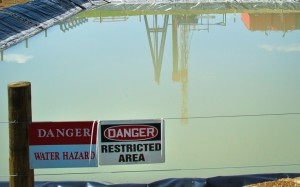Monsanto has a bad track record when it comes to the safety of its products. From saccharin, to Agent Orange, to DDT, Monsanto has a history of producing and distributing chemicals that have serious health consequences. Most recently, the company has come under pressure for its herbicide, Roundup. After years of consumer concern, world-leading scientists at the International Agency for Research on Cancer (IARC) released a study in March 2015, stating they believed glyphosate, Roundup’s active ingredient, is “probably carcinogenic”. These findings have been echoed by the World Health Organization.

Chafer Sentry Herbicide Application
This news should bring shockwaves in regulatory policy, as glyphosate is by far the most used herbicide in the world. The use of this carcinogenic herbicide has become essential for thousands of farmers who are under contract with Monsanto to use Roundup Ready genetically modified (GM) seeds. Roundup Ready crops are most heavily applied with glyphosate and these include soy, corn, canola, alfalfa, cotton, sorghum, and wheat.
Countries such as Sri Lanka, and Bermuda have banned the use and importation of glyphosate, while Germany’s health ministers are spearheading a campaign to have the herbicide banned all across the European Union. For the US, the first instance of this can be seen in the California Environmental Protection Agency’s plan to begin labeling Roundup and other products containing the chemical as carcinogenic. Dr. Nathan Donley, a scientist at the Center for Biological Diversity, stated,
“As far as I’m aware, this is the first regulatory agency in the U.S. to determine that glyphosate is a carcinogen. So this is a very big deal.”
Glyphosate’s carcinogenic potential has been known to Monsanto and the U.S. Environmental Protection Agency (EPA) from long term animal experiments since the early 1980s, but the company has repeatedly dismissed such claims and refused to disclose the studies, buy claiming they contain “trade secrets”. After petitioning the EPA, Dr. Anthony Samsel, a research expert who has worked for the EPA, and as a hazardous materials expert, the United States Army Corps of Engineers (USACE), and the United States Coast Guard (USCG), received the lab documents.
One study shows how mice exposed to glyphosate produced renal tubular adenomas, which are tumors in kidney cancer, along with developing hepatocyte hypertrophy, which is a sign of liver cancer. In addition, lab findings show how glyphosate glyphosate stops the body from absorbing selenium, which leads to thyroid cancer growth. As a result, the EPA labeled glyphosate a Class C carcinogen in a March 4, 1985 EPA review. The Class C carcinogen label means there is suggestive evidence of carcinogenic potential. This classification was changed by the EPA just six years later to a Class E category which suggests “evidence of non-carcinogenicity for humans”. Is it a coincidence that this change in glyphosate’s classification transpired during the same period that Monsanto was producing its first Roundup-Ready GM Crops?





